Appendix D: Securing Built-in Administrator Accounts in Active Directory
Applies to: Windows Server 2022, Windows Server 2019, Windows Server 2016, Windows Server 2012 R2, Windows Server 2012
Appendix D: Securing Built-in Administrator Accounts in Active Directory
In each domain in Active Directory, an Administrator account is created as part of the creation of the domain. This account is by default a member of the Domain Admins and Administrators groups in the domain. If the domain is the forest root domain, the account is also a member of the Enterprise Admins group.
Use of a domain's Administrator account should be reserved only for initial build activities, and possibly, disaster-recovery scenarios. To ensure that an Administrator account can be used to effect repairs in the event that no other accounts can be used, you should not change the default membership of the Administrator account in any domain in the forest. Instead, you should secure the Administrator account in each domain in the forest as described in the following section and detailed in the step-by-step instructions that follow.
Note
This guide used to recommend disabling the account. This was removed as the forest recovery white paper makes use of the default administrator account. The reason is, this is the only account that allows logon without a Global Catalog Server.
Controls for Built-in Administrator Accounts
For the Built-in Administrator account in each domain in your forest, you should configure the following settings:
Enable the Account is sensitive and cannot be delegated flag on the account.
Enable the Smart card is required for interactive logon flag on the account.
Configure GPOs to restrict the Administrator account's use on domain-joined systems:
In one or more GPOs that you create and link to workstation and member server OUs in each domain, add each domain's Administrator account to the following user rights in Computer Configuration\Policies\Windows Settings\Security Settings\Local Policies\User Rights Assignments:
Deny access to this computer from the network
Deny log on as a batch job
Deny log on as a service
Deny log on through Remote Desktop Services
Note
When you add accounts to this setting, you must specify whether you are configuring local Administrator accounts or domain Administrator accounts. For example, to add the TAILSPINTOYS domain's Administrator account to these deny rights, you must type the account as TAILSPINTOYS\Administrator, or browse to the Administrator account for the TAILSPINTOYS domain. If you type "Administrator" in these user rights settings in the Group Policy Object Editor, you will restrict the local Administrator account on each computer to which the GPO is applied.
We recommend restricting local Administrator accounts on member servers and workstations in the same manner as domain-based Administrator accounts. Therefore, you should generally add the Administrator account for each domain in the forest and the Administrator account for the local computers to these user rights settings. The following screenshot shows an example of configuring these user rights to block local Administrator accounts and a domain's Administrator account from performing logons that should not be needed for these accounts.
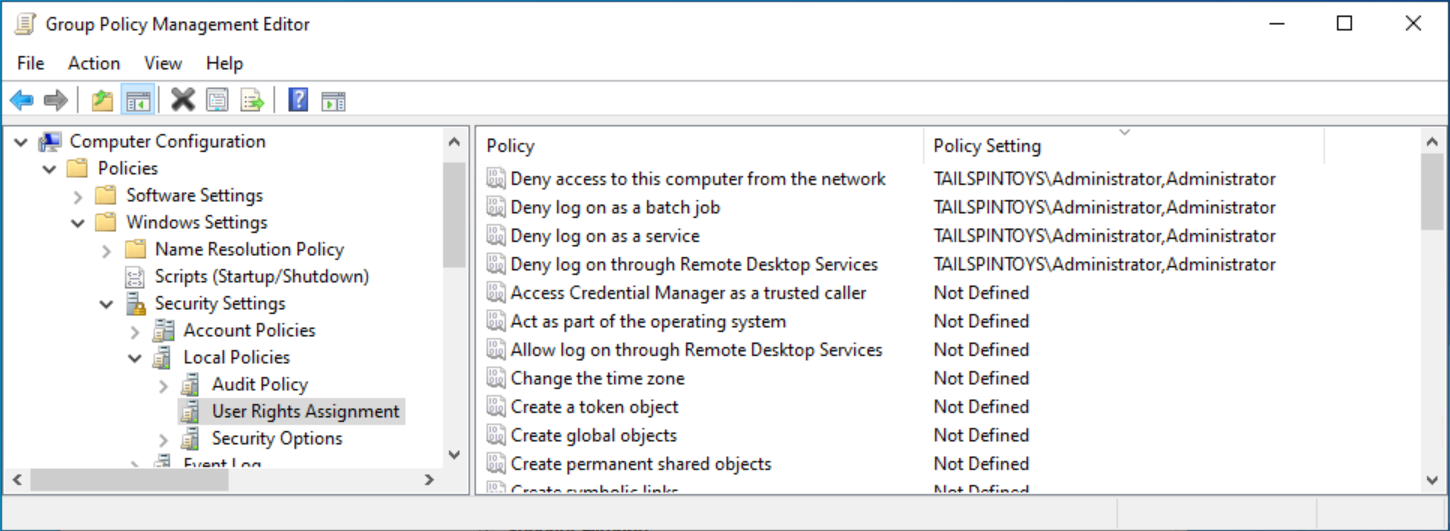
- Configure GPOs to restrict Administrator accounts on domain controllers
In each domain in the forest, the Default Domain Controllers GPO or a policy linked to the domain controllers OU should be modified to add each domain's Administrator account to the following user rights in Computer Configuration\Policies\Windows Settings\Security Settings\Local Policies\User Rights Assignments:
Deny access to this computer from the network
Deny log on as a batch job
Deny log on as a service
Deny log on through Remote Desktop Services
Note
These settings will ensure that the domain's Built-in Administrator account cannot be used to connect to a domain controller, although the account can log on locally to domain controllers. Because this account should only be used in disaster-recovery scenarios, it is anticipated that physical access to at least one domain controller will be available, or that other accounts with permissions to access domain controllers remotely can be used.
Configure Auditing of Administrator Accounts
When each domain's Administrator account is secure, you should configure auditing to monitor for usage of, or changes to the account. If the account is signed in to, its password is reset, or any other modifications are made to the account, alerts should be sent to the users or teams responsible for administration of Active Directory, in addition to incident response teams in your organization.
Step-by-Step Instructions to Secure Built-in Administrator Accounts in Active Directory
In Server Manager, select Tools, and select Active Directory Users and Computers.
To prevent attacks that leverage delegation to use the account's credentials on other systems, perform the following steps:
Right-select the Administrator account and select Properties.
Select the Account tab.
Under Account options, select Account is sensitive and cannot be delegated flag as indicated in the following screenshot, and select OK.
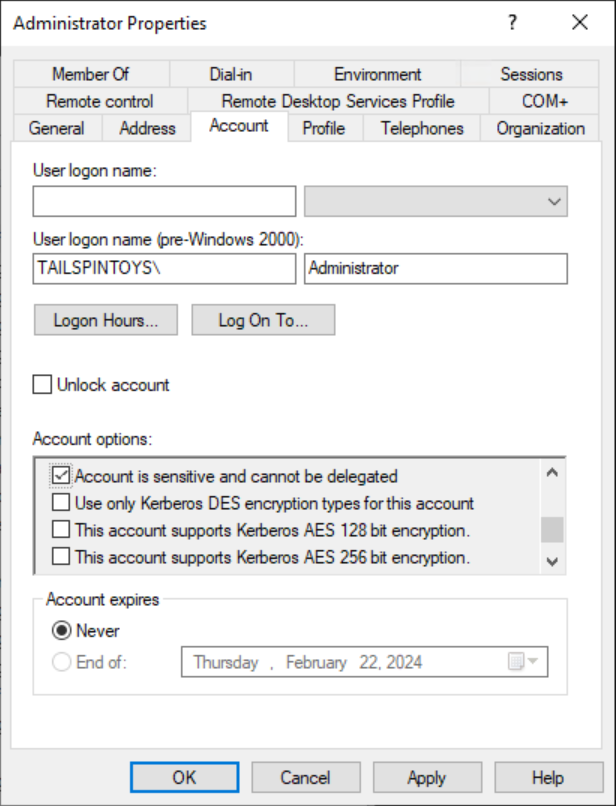
To enable the Smart card is required for interactive logon flag on the account, perform the following steps:
Right-select the Administrator account and select Properties.
Select the Account tab.
Under Account options, select the Smart card is required for interactive logon flag as indicated in the following screenshot, and select OK.
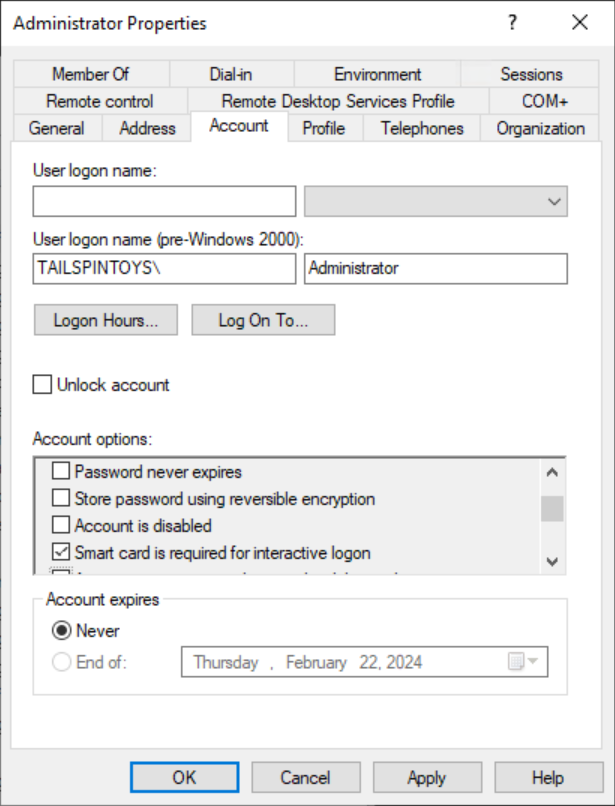
Configuring GPOs to Restrict Administrator Accounts at the Domain-Level
Warning
This GPO should never be linked at the domain-level because it can make the built-in Administrator account unusable, even in disaster recovery scenarios.
In Server Manager, select Tools, and select Group Policy Management.
In the console tree, expand <Forest>\Domains\<Domain>, and then Group Policy Objects (where <Forest> is the name of the forest and <Domain> is the name of the domain where you want to create the Group Policy).
In the console tree, right-select Group Policy Objects, and select New.
In the New GPO dialog box, type <GPO Name>, and select OK (where <GPO Name> is the name of this GPO).
In the details pane, right-select <GPO Name>, and select Edit.
Navigate to Computer Configuration\Policies\Windows Settings\Security Settings\Local Policies, and select User Rights Assignment.
Configure the user rights to prevent the Administrator account from accessing members servers and workstations over the network by performing the following steps:
Double-select Deny access to this computer from the network and select Define these policy settings.
Select Add User or Group and select Browse.
Type Administrator, select Check Names, and select OK. Verify that the account is displayed in <DomainName>\Username format as indicated in the following screenshot.
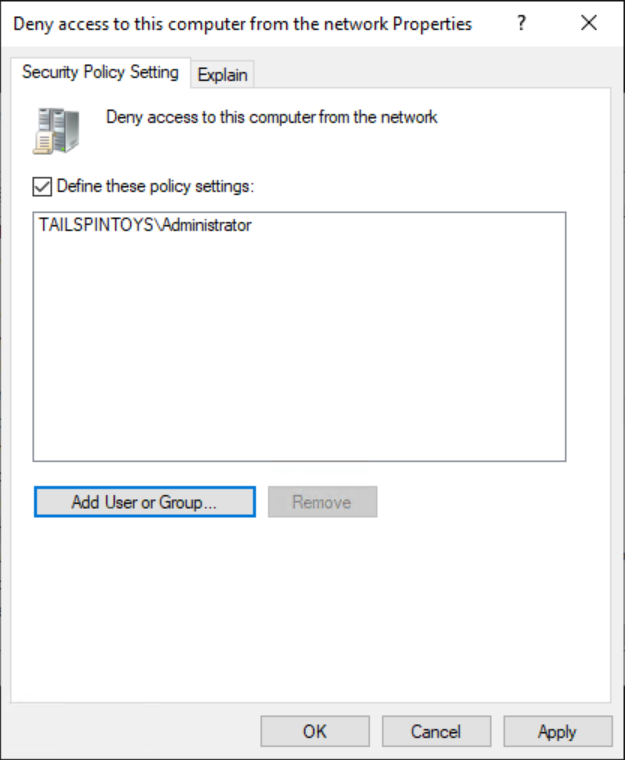
Select OK, and OK again.
Configure the user rights to prevent the Administrator account from logging on as a batch job by performing the following steps:
Double-select Deny log on as a batch job and select Define these policy settings.
Select Add User or Group and select Browse.
Type Administrator, select Check Names, and select OK. Verify that the account is displayed in <DomainName>\Username format as indicated in the following screenshot.
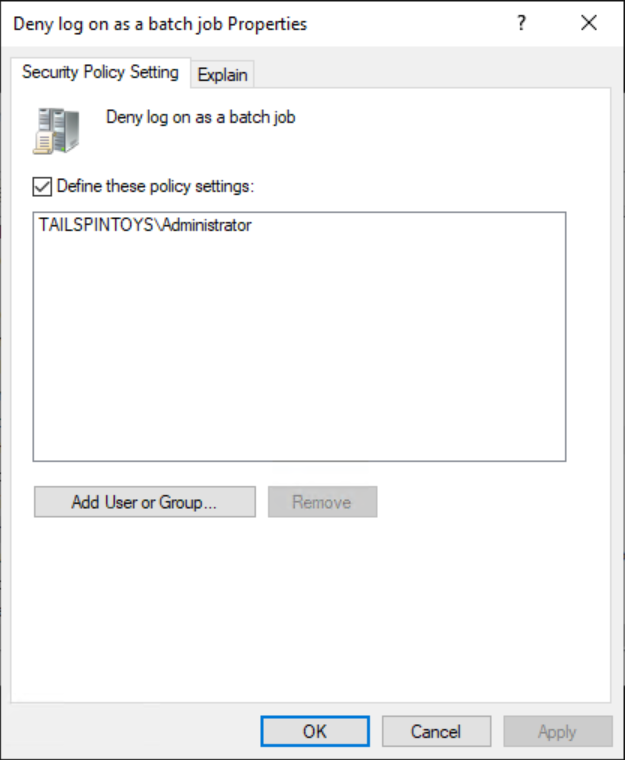
Select OK, and OK again.
Configure the user rights to prevent the Administrator account from logging on as a service by performing the following steps:
Double-select Deny log on as a service and select Define these policy settings.
Select Add User or Group and select Browse.
Type Administrator, select Check Names, and select OK. Verify that the account is displayed in <DomainName>\Username format as indicated in the following screenshot.
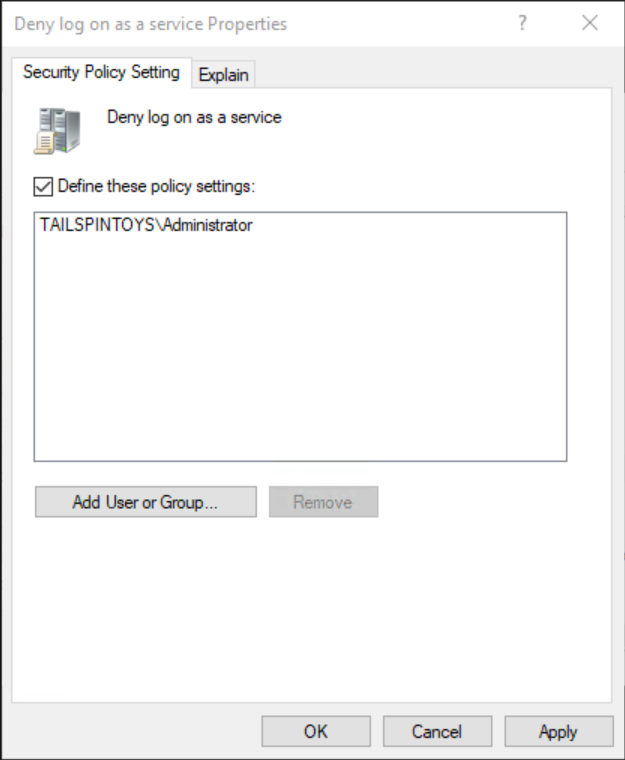
Select OK, and OK again.
Configure the user rights to prevent the Administrator account from accessing member servers and workstations via Remote Desktop Services by performing the following steps:
Double-select Deny log on through Remote Desktop Services and select Define these policy settings.
Select Add User or Group and select Browse.
Type Administrator, select Check Names, and select OK. Verify that the account is displayed in <DomainName>\Username format as indicated in the following screenshot.
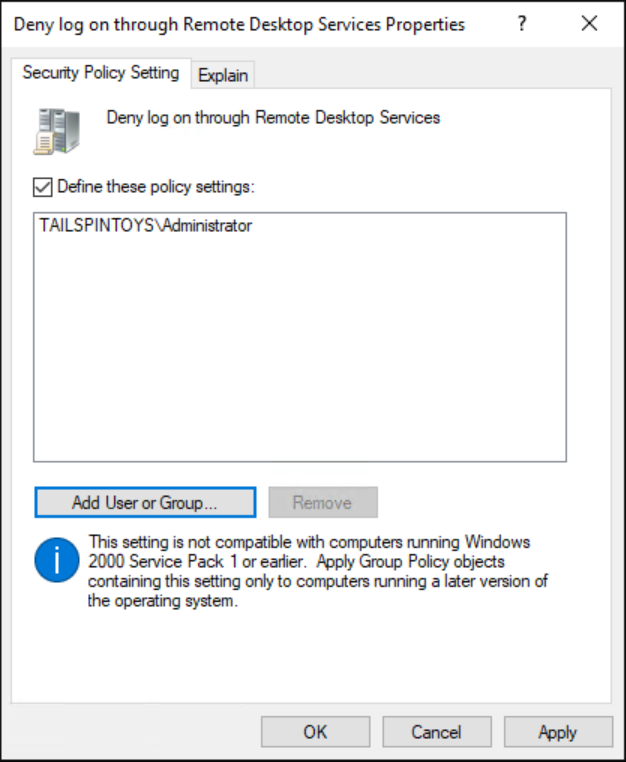
Select OK, and OK again.
To exit Group Policy Management Editor, select File, and select Exit.
In Group Policy Management, link the GPO to the member server and workstation OUs by performing the following steps:
Navigate to the <Forest>\Domains\<Domain> (where <Forest> is the name of the forest and <Domain> is the name of the domain where you want to set the Group Policy).
Right-select the OU that the GPO will be applied to and select Link an existing GPO.
Select the GPO that you created and select OK.
Create links to all other OUs that contain workstations.
Create links to all other OUs that contain member servers.
Important
When you add the Administrator account to these settings, you specify whether you are configuring a local Administrator account or a domain Administrator account by how you label the accounts. For example, to add the TAILSPINTOYS domain's Administrator account to these deny rights, you would browse to the Administrator account for the TAILSPINTOYS domain, which would appear as TAILSPINTOYS\Administrator. If you type "Administrator" in these user rights settings in the Group Policy Object Editor, you will restrict the local Administrator account on each computer to which the GPO is applied, as described earlier.
Verification Steps
The verification steps outlined here are specific to Windows 8 and Windows Server 2012.
Verify "Smart card is required for interactive logon" Account Option
- From any member server or workstation affected by the GPO changes, attempt to log on interactively to the domain by using the domain's built-in Administrator account. After attempting to log on, a dialog box will appear informing you that you require a smart card to sign in.
Verify "Deny access to this computer from the network" GPO Settings
Attempt to access a member server or workstation over the network that affected by the GPO changes from a member server or workstation that is not affected by the GPO changes. To verify the GPO settings, attempt to map the system drive by using the NET USE command by performing the following steps:
Log on to the domain using the domain's Built-in Administrator account.
Right select on the Start hint and choose Windows PowerShell (Admin).
When prompted to approve the elevation, select Yes.
In the PowerShell window, type net use \\<Server Name>\c$, where <Server Name> is the name of the member server or workstation you are attempting to access over the network.
You should receive a message that the user has not been granted the requested logon type.
Verify "Deny log on as a batch job" GPO Settings
From any member server or workstation affected by the GPO changes, log on locally.
Create a Batch File
Select the Start hint and type Notepad.
On the list of results, select Notepad.
In Notepad, type dir c:.
Select File and Select Save As.
In the Filename field, type <Filename>.bat (where <Filename> is the name of the new batch file).
Schedule a Task
Select the Start hint, type task scheduler, and select Task Scheduler.
On Task Scheduler, select Action, and select Create Task.
In the Create Task dialog box, type <Task Name> (where <Task Name> is the name of the new task).
Select the Actions tab, and select New.
Under Action:, select Start a program.
Under Program/script:, select Browse, locate and select the batch file created in the "Create a Batch File" section, and select Open.
Select OK.
Select the General tab.
Under Security options, select Change User or Group.
Type the name of the Administrator account at the domain-level, select Check Names, and select OK.
Select Run whether the user is logged on or not and Do not store password. The task will only have access to local computer resources.
Select OK.
A dialog box should appear, requesting user account credentials to run the task.
After entering the credentials, select OK.
You will be presented with a dialog box informing you that the task requires an account with Log on as a batch job rights.
Verify "Deny log on as a service" GPO Settings
From any member server or workstation affected by the GPO changes, log on locally.
Select the Start hint, type services, and select Services.
Locate and double-select Print Spooler.
Select the Log On tab.
Under Log on as:, select This account.
Select Browse, type the name of the Administrator account at the domain-level, select Check Names, and select OK.
Under Password: and Confirm password:, type the Administrator account's password, and select OK.
Select OK three more times.
Right-select the Print Spooler service and select Restart.
When the service is restarted, a dialog box will inform you that the Print Spooler service could not be started.
Revert Changes to the Printer Spooler Service
From any member server or workstation affected by the GPO changes, log on locally.
Select the Start hint, type services, and select Services.
Locate and double-select Print Spooler.
Select the Log On tab.
Under Log on as:, select the Local System account, and select OK.
Verify "Deny log on through Remote Desktop Services" GPO Settings
Select Start and then type remote desktop connection, and select Remote Desktop Connection.
In the Computer field, type the name of the computer that you want to connect to, and select Connect. (You can also type the IP address instead of the computer name.)
When prompted, provide credentials for the name of the Administrator account at the domain-level.
The Remote Desktop Connection is denied.
Feedback
Coming soon: Throughout 2024 we will be phasing out GitHub Issues as the feedback mechanism for content and replacing it with a new feedback system. For more information see: https://aka.ms/ContentUserFeedback.
Submit and view feedback for